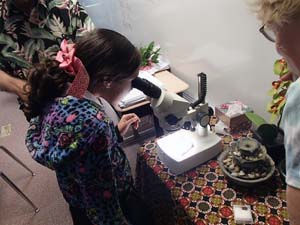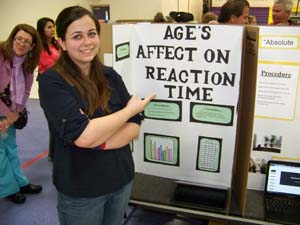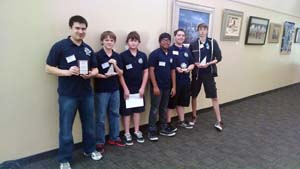Using STEM Clubs as a Catalyst for Change in K-12 Education: A Statewide Model
By Guest Blogger
Posted on 2014-09-16
 The growing abundance of research supporting the importance of incorporating increased Science, Technology, Engineering, and Math (STEM) into schools, combined with the recently vocalized excitement in regard to STEM by high profile individuals appears to be having only minimal impact in our classrooms. This appears to be the case despite all of those who have rushed to create and market STEM resources for educators. Even the growing support from industry for an increase in the integration of STEM into schools, which they have graciously shown in the form of financial support and shared expertise, has not been enough to truly ignite successful large scale integration of STEM in schools (Ryan, 2012).
The growing abundance of research supporting the importance of incorporating increased Science, Technology, Engineering, and Math (STEM) into schools, combined with the recently vocalized excitement in regard to STEM by high profile individuals appears to be having only minimal impact in our classrooms. This appears to be the case despite all of those who have rushed to create and market STEM resources for educators. Even the growing support from industry for an increase in the integration of STEM into schools, which they have graciously shown in the form of financial support and shared expertise, has not been enough to truly ignite successful large scale integration of STEM in schools (Ryan, 2012).  Unfortunately this reality, however frustrating, is not new to educational reform efforts. History has shown that many well intended, research backed educational reform efforts have failed due to a lack of understanding and support for such change. Although this appears to be the path that many of the efforts in regard to STEM are on, there are signs of hope. In Arizona, over the past three years, we at Science Foundation Arizona have seen our efforts in regard to STEM clubs ignite a statewide movement which is beginning to serve as a catalyst for helping educators, students, parents, and the larger community to understand and support the need for increasing the integration of STEM into our schools. While we acknowledge that this may only be a first step in the process to fully integrate STEM into our schools, we see it as a vital one to move forward toward large-scale sustainable integration of STEM into our classrooms.
Unfortunately this reality, however frustrating, is not new to educational reform efforts. History has shown that many well intended, research backed educational reform efforts have failed due to a lack of understanding and support for such change. Although this appears to be the path that many of the efforts in regard to STEM are on, there are signs of hope. In Arizona, over the past three years, we at Science Foundation Arizona have seen our efforts in regard to STEM clubs ignite a statewide movement which is beginning to serve as a catalyst for helping educators, students, parents, and the larger community to understand and support the need for increasing the integration of STEM into our schools. While we acknowledge that this may only be a first step in the process to fully integrate STEM into our schools, we see it as a vital one to move forward toward large-scale sustainable integration of STEM into our classrooms.
 Three years ago, defining STEM clubs as “any gathering of students that meets regularly in an informal environment to work on inquiry-based STEM related activities,” Science Foundation Arizona piloted STEM clubs in eleven schools. Each school received supplies, teacher stipends, and professional development. What we learned from these efforts was that there was an interest in STEM clubs across the state and that STEM clubs opened up possibilities that other types of specialized clubs, such as full robotics clubs, did not. Unlike these specialized clubs, STEM clubs appealed to all grade levels, especially K–8, and they allowed teachers and students to adjust the level and focus of the club in order to meet student needs and interests. With this knowledge in hand, we set out to develop a STEM club model that could be replicated on a large scale. At this time we were also working on developing a statewide network of Informal STEM Providers, which included representatives from education, business, government, and non-profit organizations with an interest in Informal STEM. Early in our second year of these efforts our work in these two areas came together when we realized that a number of our Informal partners had also been experimenting with STEM clubs. As a result, we began to coordinate our efforts and our lessons learned. Within six months we had developed an inexpensive STEM club model, and an online STEM Club Guide, which not only provides schools with guidance on how to setup and support a STEM club, but also has the ability to connect these clubs to one another, allowing them to share resources, collaborate on projects, and provide each other support regardless of geographic limitations. This free online resource can be found at stemclubguide.sfaz.org.
Three years ago, defining STEM clubs as “any gathering of students that meets regularly in an informal environment to work on inquiry-based STEM related activities,” Science Foundation Arizona piloted STEM clubs in eleven schools. Each school received supplies, teacher stipends, and professional development. What we learned from these efforts was that there was an interest in STEM clubs across the state and that STEM clubs opened up possibilities that other types of specialized clubs, such as full robotics clubs, did not. Unlike these specialized clubs, STEM clubs appealed to all grade levels, especially K–8, and they allowed teachers and students to adjust the level and focus of the club in order to meet student needs and interests. With this knowledge in hand, we set out to develop a STEM club model that could be replicated on a large scale. At this time we were also working on developing a statewide network of Informal STEM Providers, which included representatives from education, business, government, and non-profit organizations with an interest in Informal STEM. Early in our second year of these efforts our work in these two areas came together when we realized that a number of our Informal partners had also been experimenting with STEM clubs. As a result, we began to coordinate our efforts and our lessons learned. Within six months we had developed an inexpensive STEM club model, and an online STEM Club Guide, which not only provides schools with guidance on how to setup and support a STEM club, but also has the ability to connect these clubs to one another, allowing them to share resources, collaborate on projects, and provide each other support regardless of geographic limitations. This free online resource can be found at stemclubguide.sfaz.org.
 With all of this in place, we launched this new club model and online guide at the first Arizona STEM Club Conference in July 2013. This conference attracted over 120 educators from over 90 schools in 9 Arizona counties. Following this conference we provided 70 of the attending schools seed funding of approximately $750 to help them setup and support a STEM club. Supported with these minimal funds, these 70 clubs ran through the 2013–2014 school year directly serving over 1000 students, and many of these clubs are continuing for the next school year. Working with these clubs throughout the year, we quickly learned that the beauty in this simple, inexpensive STEM club model was that it could be tailored to the needs of the school, teachers, and students. Teachers involved in these clubs claim they were not overwhelmed by resources and content that they did not understand, and as a result many saw these clubs as a way to “test” ideas they had for teaching in the STEM
With all of this in place, we launched this new club model and online guide at the first Arizona STEM Club Conference in July 2013. This conference attracted over 120 educators from over 90 schools in 9 Arizona counties. Following this conference we provided 70 of the attending schools seed funding of approximately $750 to help them setup and support a STEM club. Supported with these minimal funds, these 70 clubs ran through the 2013–2014 school year directly serving over 1000 students, and many of these clubs are continuing for the next school year. Working with these clubs throughout the year, we quickly learned that the beauty in this simple, inexpensive STEM club model was that it could be tailored to the needs of the school, teachers, and students. Teachers involved in these clubs claim they were not overwhelmed by resources and content that they did not understand, and as a result many saw these clubs as a way to “test” ideas they had for teaching in the STEM  disciplines while working on improving their own content knowledge, without the threat of standardized accountability. Similarly students in these clubs have shared with us that they were excited because these clubs “made science and math interesting and fun.” We are already seeing this having an initial impact on students’ interest in school, in STEM, and in some cases on their achievement in the STEM disciplines. In addition, most of these clubs did community events and outreach, which helped them to gain community support for STEM, and in some cases additional funding for their efforts. Finally, schools appear to be supportive of these clubs most likely because they are inexpensive and were initiated by interested teachers and students.
disciplines while working on improving their own content knowledge, without the threat of standardized accountability. Similarly students in these clubs have shared with us that they were excited because these clubs “made science and math interesting and fun.” We are already seeing this having an initial impact on students’ interest in school, in STEM, and in some cases on their achievement in the STEM disciplines. In addition, most of these clubs did community events and outreach, which helped them to gain community support for STEM, and in some cases additional funding for their efforts. Finally, schools appear to be supportive of these clubs most likely because they are inexpensive and were initiated by interested teachers and students.
 Moving into our third year of these efforts, we held the 2nd Annual Arizona STEM Clubs Conference in June 2014. At this year’s event we had over 220 educators from over 150 schools representing 13 of the 15 counties in Arizona. This summer we will provide seed or expansion funding, at approximately $500 per club, to over 110 clubs, 90 of which will be new clubs. This being the case, we expect to have almost 200 STEM clubs across the state networked through our online STEM Club Guide in the next few months. Based on last years impact rate, this gives us the potential to directly impact at least 2,000 to 3,000 students this year. In addition we have had inquiries from educators in three other states looking to use our STEM club model and online resources to start or expand STEM club efforts in their states.
Moving into our third year of these efforts, we held the 2nd Annual Arizona STEM Clubs Conference in June 2014. At this year’s event we had over 220 educators from over 150 schools representing 13 of the 15 counties in Arizona. This summer we will provide seed or expansion funding, at approximately $500 per club, to over 110 clubs, 90 of which will be new clubs. This being the case, we expect to have almost 200 STEM clubs across the state networked through our online STEM Club Guide in the next few months. Based on last years impact rate, this gives us the potential to directly impact at least 2,000 to 3,000 students this year. In addition we have had inquiries from educators in three other states looking to use our STEM club model and online resources to start or expand STEM club efforts in their states.
 Now, of course, the cynic may question, how will any of this impact student achievement? This criticism can be answered in a number of ways. First, research suggests that student achievement may be closely tied to motivation (Faryadi, 2007), and our efforts are already showing support for this claim. In a number of cases we are already seeing that these STEM clubs, which provide a simple way to motivate both students and teachers, are leading to increases in student achievement in the STEM disciplines. We intend to continue to monitor this in order to provide stronger support for this connection. In addition, there have been a number of recent studies showing a direct correlation between participation in out-of-school STEM activities and increased achievement in STEM disciplines (Sahin et. al., 2014). All of this being said, however, what is most exciting about the results we are seeing in our STEM club efforts in Arizona is that we have realized that we have not started a STEM club program, but rather a STEM club movement, and as Apple (2010) states, it is social movements that, “are the real engines of educational transformations.”
Now, of course, the cynic may question, how will any of this impact student achievement? This criticism can be answered in a number of ways. First, research suggests that student achievement may be closely tied to motivation (Faryadi, 2007), and our efforts are already showing support for this claim. In a number of cases we are already seeing that these STEM clubs, which provide a simple way to motivate both students and teachers, are leading to increases in student achievement in the STEM disciplines. We intend to continue to monitor this in order to provide stronger support for this connection. In addition, there have been a number of recent studies showing a direct correlation between participation in out-of-school STEM activities and increased achievement in STEM disciplines (Sahin et. al., 2014). All of this being said, however, what is most exciting about the results we are seeing in our STEM club efforts in Arizona is that we have realized that we have not started a STEM club program, but rather a STEM club movement, and as Apple (2010) states, it is social movements that, “are the real engines of educational transformations.”
References
Apple, M. (2010). On Being a Scholar/Activist in Education. In E.C. Short & L. J. Waks (Eds.), Leaders in Curriculum Studies: Intellectual Self Portraits (pp. 1–17). Rotterdam: Sense Publishers.
Faryadi, Q. (2007). Instructional design models: What a revolution! ERIC, Retrieved from www.eric.ed.gov/PDFS/ED495711.pdf
Ryan, R. (2012). Why STEM Isn’t Working: A dangerous disconnect between think and feel. Madison Magazine. Retrieved from www.madisonmagazine.com/Madison-Magazine/October-2012/Why-STEM-Isnt-Working/
Sahin, A., Ayar, M., & Adriguzel, T. (2014). STEM Related After-School Program Activities and Associated Outcomes on Student Learning. Educational Sciences: Theory & Practice, 14(1), 309–322. doi:10.12738/estp.2014.1.1876
Stephaine Frimer, M.Ed. is the STEM Field Representative at Science Foundation Arizona. She can be reached at sfrimer@sfaz.org; the Science Foundation Arizona is on Twitter @ScienceFoundAz.
Follow NSTA
| |
|
|
|
Disclaimer: The views expressed in this blog post are those of the author(s) and do not necessarily reflect the official position of the National Science Teaching Association (NSTA).



